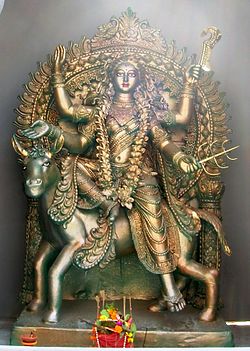Kaalratri


Kaalratri (sometimes spelled Kalaratri) is the seventh form amongst the Navadurga (ie. the nine forms of Hindu Mother Goddess referenced in Durga Saptashati, Chapters 81-93 of the Markandeya Purana, the earliest known literature on Goddess Durga). Goddess Kaalratri is widely regarded as one of the many destructive forms of Mother Goddess - Kali, Mahakali, Bhadrakali, Bhairavi, Mrityu, Rudrani, Chamunda, Chandi and Durga.
It is important to note that it is not uncommon to find the names, Kali and Kaalratri being used interchangeably, although these two deities are argued to be separate entities by some.[2] According to David Kinsley, Kali is first mentioned in Hinduism as a distinct goddess around 600 CE. Chronologically then, Kaalratri (described textually in the Mahabharata, dated 300 BCE - 300 CE) predates but most likely, informs, present representations of Kali.
Kaalratri is traditionally worshipped during the nine nights of Navratri celebrations. The seventh day of Navratri pooja (Hindu prayer ritual) in particular is dedicated to her and she is considered the fiercest form of the Mother Goddess, her appearance itself invoking fear. This form of Goddess is believed to be the destroyer of all demon entities, ghosts, spirits and negative energies, who flee upon knowing of her arrival.
The Saudhikagama, an ancient Tantric text referenced in the Silpa Prakasha, describes Goddess Kalaratri as being the goddess that rules the night portion of every day and night. She is also associated with the crown chakra (also known as the sahasrara chakra), thereby giving the invoker, siddhis and niddhis (particularly, knowledge, power and wealth).
Kaalratri is also known as Shubankari - meaning auspicious/doing good in Sanskrit, due to the belief that she always provides auspicious results to her devotees. Hence, it is believed that she makes her devotees fearless.
Other less well-known names of Goddess Kaalratri include Raudri and Dhumorna.